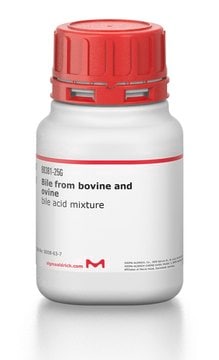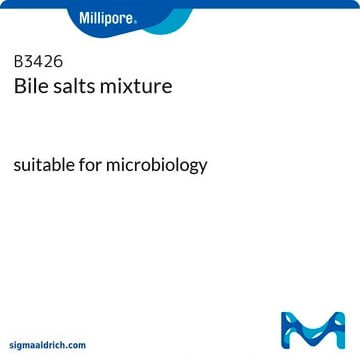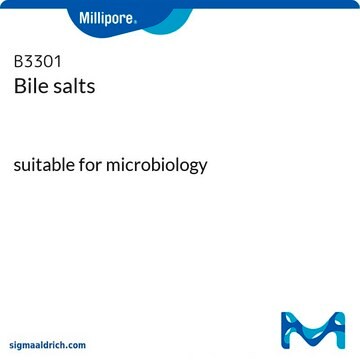B8756
Bile salts
suitable for microbiology
Synonym(s):
Bile acids sodium salt, cholic acid-deoxycholic acid sodium salt mixture
Sign Into View Organizational & Contract Pricing
All Photos(1)
About This Item
UNSPSC Code:
41106212
NACRES:
NA.85
Recommended Products
sterility
non-sterile
Quality Level
form
powder
solubility
distilled water: freely soluble
application(s)
microbiology
storage temp.
10-30°C
General description
Bile salt is an organic sodium salt with a conjugate of any of the bile acids along with either glycine or taurine. Biles salts are composed of four different kinds of bile acids - cholic, deoxycholic, chenodeoxycholic and lithocholic acids.Bile salts are extracted under controlled conditions from purified fresh bile, to be used in bacteriological culture media, where it behaves as a selective inhibitory agent that enables isolation and identification of pathogens. For example, in MacConkey Agar/Broth.
Application
Bile salts may be used as one of the selective agents to prevent the growth of injured Escherichia coli cells, in an experiment done in order to identify the specific agent in the selective media which would inhibit the growth of the injured Escherichia coli ML30 cells. It may also be used for identification of isolates of Vibrio (Beneckea) vulnificus which is a halophilic bacterium, found responsible for causing several human infections.
Other Notes
Mixture of sodium cholate and sodium deoxycholate
Storage Class Code
11 - Combustible Solids
WGK
WGK 3
Flash Point(F)
Not applicable
Flash Point(C)
Not applicable
Personal Protective Equipment
dust mask type N95 (US), Eyeshields, Gloves
Choose from one of the most recent versions:
Certificates of Analysis (COA)
Lot/Batch Number
Don't see the Right Version?
If you require a particular version, you can look up a specific certificate by the Lot or Batch number.
Already Own This Product?
Find documentation for the products that you have recently purchased in the Document Library.
Customers Also Viewed
Divya Eratte et al.
Food chemistry, 227, 129-136 (2017-03-10)
Solid co-microcapsules of omega-3 rich tuna oil and probiotic bacteria L. casei were produced using whey protein isolate-gum Arabic complex coacervate as wall material. The in-vitro digestibility of the co-microcapsules and microcapsules was studied in terms of survival of L.
Lian-Hua Cui et al.
Journal of microbiology and biotechnology, 28(4), 510-519 (2018-02-01)
Synbiotics are a combination of probiotics and prebiotics, which lead to synergistic benefits in host welfare. Probiotics have been used as an alternative to antibiotics. Among the probiotics, Pediococcus acidilactici (PA) has shown excellent antimicrobial activity against Salmonella Gallinarum (SG)
Christina S Faherty et al.
Molecular microbiology, 85(1), 107-121 (2012-05-11)
Shigella flexneri is a Gram-negative pathogen that invades the colonic epithelium. While invasion has been thoroughly investigated, it is unknown how Shigella first attaches to the epithelium. Previous literature suggests that Shigella utilizes adhesins that are induced by environmental signals
D L Scheusner et al.
Applied microbiology, 21(1), 46-49 (1971-01-01)
A population of Escherichia coli ML30 cells was exposed to a quaternary ammonium compound, and injury to the cells was measured by a comparison of counts on Trypticase Soy Agar and Violet Red Bile Agar. Substantial injury could not be
Gordana Panic et al.
Parasites & vectors, 6, 237-237 (2013-08-15)
Echinostomiasis is one of the major food-borne trematodiases and the species Echinostoma caproni serves as a useful model for trematocidal drug discovery. The current in vitro drug sensitivity assay uses adult E. caproni worms that are incubated with candidate drugs
Our team of scientists has experience in all areas of research including Life Science, Material Science, Chemical Synthesis, Chromatography, Analytical and many others.
Contact Technical Service











